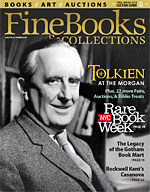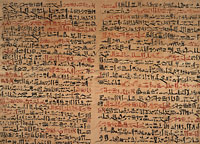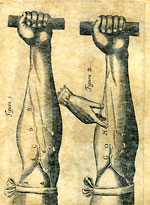Medical Manuscripts & More
The New York Academy of Medicine’s rare treasures include the Edwin Smith Papyrus and a prototype for George Washington’s dentures. By Richard Goodman
Recently the New York Academy of Medicine’s library—previously known only to a small group of doctors, scholars, historians, and sundry researchers—garnered some of the national attention it deserves in a New York Times article. Standing in the shadow of the New York Public Library, the Morgan Library, and the Grolier Club (it is easy to be a bibliophile in New York), NYAM’s library has been something of a secret. The fact is, though, the library, with its vast collection of 550,000 books—including 32,000 rare volumes—400,000 pamphlets and 75,000 free-standing images (photographs, engravings, prints, etc.) relating to European and American medicine, is the sole medical library in New York that’s open to the public. Asked what she sees as the mission of the library, Janice Kaplan, who has been the library’s director for the last eight years, said, simply, “to support the needs of the public.”
The NYAM was founded in 1847. It was created so that New York physicians could have some influence in matters of medical practice and public health reform in New York City. Its membership consists of elected fellows. (There are currently about 2,000 from all over the world.) Since 1926, it has resided in what is its third home, an imposing Romanesque building on Fifth Avenue at 103rd Street, directly across from Central Park, and within shouting distance of the Guggenheim Museum and some of New York’s most prestigious addresses. In the November New York Times article, writer Geraldine Fabrikant reported that one visitor compared the elegance of NYAM’s library to the Frick Collection.
The library has been open to the public since 1878. It has amassed quite a remarkable collection since its inception, largely through donated collections of its fellows. This includes 85 percent of the books, pamphlets, periodicals, and broadsides of medical interest printed in North America between the late sixteenth century and the early nineteenth century. The collection is also wide in scope. It contains, for example, extensive holdings on the history of obstetrics and gynecology and on diseases of the skin, as well as a large collection of books and pamphlets on homeopathic and patent medicine. The library also possesses a substantial collection of cookbooks, including a ninth century manuscript, De Re Coquinaria (On the Subject of Cooking), a book of Roman cookery recipes said to have been amassed in the fourth century AD. The library even has a prototype of George Washington’s dentures and a set of amputation tools from 1820.
The rare book collection has seminal European works on medicine, including what the curator of rare books, Miriam Mandelbaum, considers some of the most important. One gem is De Humani Corporis Fabrica by the Flemish anatomist Andreas Vesalius (1514-1564). Vesalius revolutionized the study of anatomy with the simple but profound stricture that the person writing about, and describing, human anatomy ought to be the same person who actually examines the bodies he is describing. This had not been the case previously. Galen, the great authority on anatomy before Vesalius, produced his ideas on human anatomy from dissecting monkeys. The book is a series of prints, each showing how the human body is “fabricated,” some with the muscle dripping away from the body part in question. The book was printed in Basel in 1543, and, as in many instances of early printing, one is struck by the formidable quality of the work, a mere hundred years after Gutenberg.
The New York Academy of Medicine Library
1216 Fifth Avenue (at 103rd St.)
New York, NY 10029
Main Reading Room Hours
Monday: Closed – reference service will be provided via telephone or e-mail 9 a.m. to 5 p.m.
Tuesday to Friday: 10:00 a.m. – 4:45 p.m.
(212) 822-7315
Rare Book Room Hours
Tuesday, Thursday, Friday: 10:00 a.m. – 4:45 p.m.
Wednesday: 10:00 a.m. – 7:00 p.m.
By appointment only; no weekend hours
(212) 822-7310/7313
The Academy also possesses what Mandelbaum considers “the single most important document in medicine,” Exercitatio Anatomica de Motu Cordis et Sanguinis in Animalibus by William Harvey. This 72-page book, published in 1628 in Frankfurt, explains, for the first time, how blood circulates in the body. Only thirty-nine copies exist; the library has two of them. The holdings also include the first Greek edition of Hippocrates’ complete works, Απαντα τα του Ιπποκρατους : Omnia opera Hippocratis, published in Venice in 1526. Perhaps the library’s most prized possession is the Edwin Smith Papyrus. One of the world’s oldest scientific documents, this fifteen-foot papyrus deals with the treatment of wounds both practically and magically. Written in the hieratic script of the ancient Egyptian language around the sixteenth century BC, it’s based on material from a thousand years earlier. The document consists of a list of 48 traumatic injury cases, each with a description of the physical examination, treatment, and prognosis. It is currently on loan to the Metropolitan Museum of Art.
Director Kaplan says that one of the library’s main objectives is to digitize as much of the collection as possible and as soon as possible. So far they’ve been able to digitize just one percent of the collection. One reason, of course, is funding. But another is that many of their materials are in tenuous condition.
“We can’t do this like, say, Google does, en masse,” Kaplan said. “We normally have to supervise the process, and that takes time.”
Meanwhile, the secret is out: the NYAM library is full of bibliophilic delights, and is open to the public.














 Richard Goodman is the author of The Soul of Creative Writing and French Dirt: The Story of a Garden in the South of France. A founding member of the New York Writers Workshop, Goodman teaches creative nonfiction at Spalding University in Louisville, Kentucky. He’s written for the New York Times, the Harvard Review, Commonweal, Saveur, the Michigan Quarterly Review and many other publications. His essay, “In Search of the Exact Word,” was included in the Oxford American Writer’s Thesaurus. He lives in New York City. Read more at www.richardgoodman.org
Richard Goodman is the author of The Soul of Creative Writing and French Dirt: The Story of a Garden in the South of France. A founding member of the New York Writers Workshop, Goodman teaches creative nonfiction at Spalding University in Louisville, Kentucky. He’s written for the New York Times, the Harvard Review, Commonweal, Saveur, the Michigan Quarterly Review and many other publications. His essay, “In Search of the Exact Word,” was included in the Oxford American Writer’s Thesaurus. He lives in New York City. Read more at www.richardgoodman.org